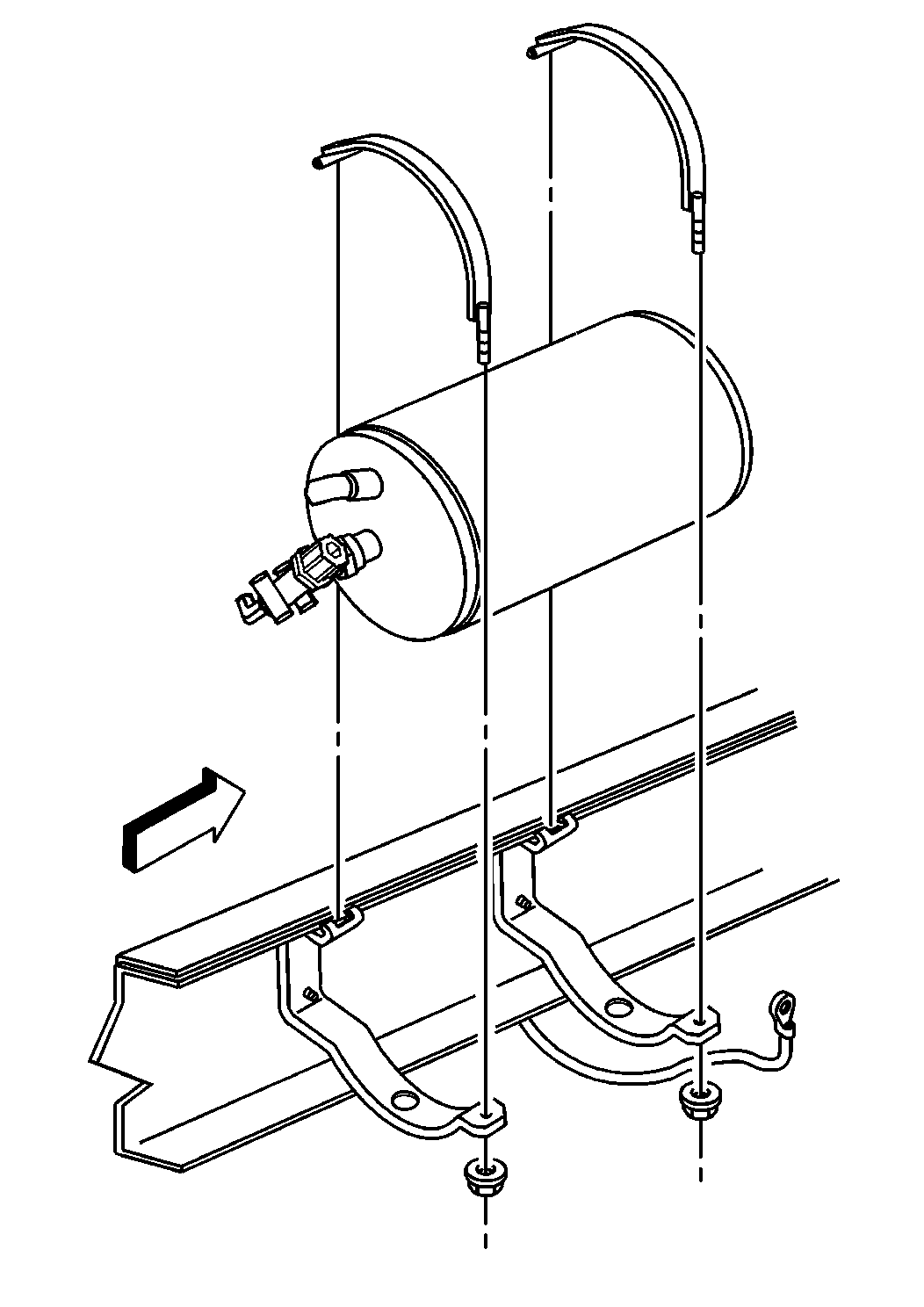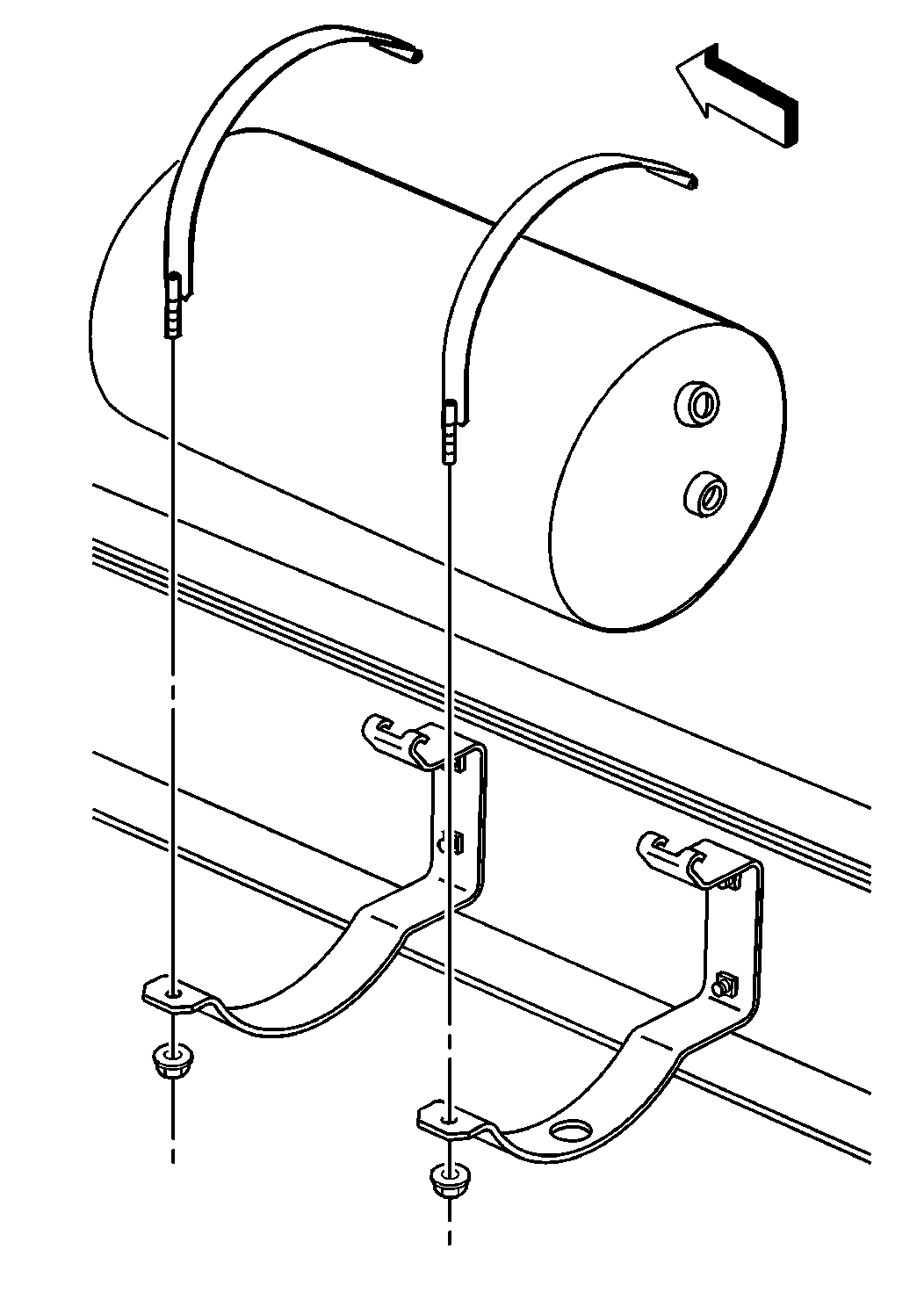Reservoir Replacement Supply
Removal Procedure
- Apply the parking brake.
- Block the wheels.
- Drain all the reservoirs. Refer to
Draining Reservoirs
- Remove the air lines. Refer to
Trailer Coupling Hose and Line Bracket Replacement
.

- Remove the strap nuts.
- Remove the straps from the air reservoir supports.
- Remove the air reservoir.
- Clean the air lines clean and the fittings with a dry cloth.
- Clean the inside reservoir with steam or hot water.
- Inspect the air lines for the following conditions:
- Replace any damaged, cracked, bulged, or worn air lines.
- Inspect the air reservoir for corrosion or damage. Replace the
reservoir if weakened.
- Inspect the air reservoir supports and inspect the straps for
damage. Replace the supports and the straps as needed.
Installation Procedure
- Install the air reservoir.
- Install the straps to the air reservoir supports.

Notice: Use the correct fastener in the correct location. Replacement fasteners
must be the correct part number for that application. Fasteners requiring
replacement or fasteners requiring the use of thread locking compound or sealant
are identified in the service procedure. Do not use paints, lubricants, or
corrosion inhibitors on fasteners or fastener joint surfaces unless specified.
These coatings affect fastener torque and joint clamping force and may damage
the fastener. Use the correct tightening sequence and specifications when
installing fasteners in order to avoid damage to parts and systems.
- Install the strap
nuts.
Tighten
Tighten the strap nuts to 23 N·m (17 lb ft).
- Install the air lines.
- Start the engine.
- Charge the system air pressure to the governor cut-out point.
- Check for leaks with a soap solution. Leakage is not permissible.
- Test the brakes for proper operation.
- Remove the wheel blocks.
Reservoir Replacement Front Service
Removal Procedure
- Apply the parking brake.
- Block the wheels.
- Drain all the reservoirs. Refer to
Draining Reservoirs
.
- Remove the air lines. Refer to
Trailer Coupling Hose and Line Bracket Replacement
.

- Remove the strap nuts.
- Remove the straps from the air reservoir supports.
- Remove the air reservoir.
- Clean the air lines clean and the fittings with a dry cloth.
- Clean the inside reservoir with steam or hot water.
- Inspect the air lines for the following conditions:
- Replace any damaged, cracked, bulged, or worn air lines.
- Inspect the air reservoir for corrosion or damage. Replace the
reservoir if weakened.
- Inspect the air reservoir supports and inspect the straps for
damage. Replace as needed.
Installation Procedure
- Install the air reservoir.
- Install the straps to the air reservoir supports.

Notice: Use the correct fastener in the correct location. Replacement fasteners
must be the correct part number for that application. Fasteners requiring
replacement or fasteners requiring the use of thread locking compound or sealant
are identified in the service procedure. Do not use paints, lubricants, or
corrosion inhibitors on fasteners or fastener joint surfaces unless specified.
These coatings affect fastener torque and joint clamping force and may damage
the fastener. Use the correct tightening sequence and specifications when
installing fasteners in order to avoid damage to parts and systems.
- Install the strap
nuts.
Tighten
Tighten the strap nuts to 40 N·m (29 lb ft).
- Install the air lines.
- Start the engine.
- Charge the system air pressure to the governor cut-out point.
- Check for leaks with a soap solution. Leakage is not permissible.
- Test the brakes for proper operation.
- Remove the wheel blocks.
Reservoir Replacement Truck Rear Service
Removal Procedure
- Apply the parking brake.
- Block the wheels.
- Drain all the reservoirs. Refer to
Draining Reservoirs
- Remove the air lines. Refer to
Trailer Coupling Hose and Line Bracket Replacement
.

- Remove the strap nuts.
- Remove the straps from the air reservoir supports.
- Remove the air reservoir.
- Clean the air lines clean and the fittings with a dry cloth.
- Clean the inside reservoir with steam or hot water.
- Inspect the air lines for the following conditions:
- Replace any damaged, cracked, bulged, or worn air lines.
- Inspect the air reservoir for corrosion or damage. Replace the
reservoir if weakened.
- Inspect the air reservoir supports and inspect the straps for
damage. Replace the supports and the straps as needed.
Installation Procedure
- Install the air reservoir.
- Install the straps to the air reservoir supports.

Notice: Use the correct fastener in the correct location. Replacement fasteners
must be the correct part number for that application. Fasteners requiring
replacement or fasteners requiring the use of thread locking compound or sealant
are identified in the service procedure. Do not use paints, lubricants, or
corrosion inhibitors on fasteners or fastener joint surfaces unless specified.
These coatings affect fastener torque and joint clamping force and may damage
the fastener. Use the correct tightening sequence and specifications when
installing fasteners in order to avoid damage to parts and systems.
- Install the strap
nuts.
Tighten
Tighten the strap nuts to 23 N·m (17 lb ft).
- Install the air lines.
- Start the engine.
- Charge the system air pressure to the governor cut-out point.
- Check for leaks with a soap solution. Leakage is not permissible.
- Test the brakes for proper operation.
- Remove the wheel blocks.






